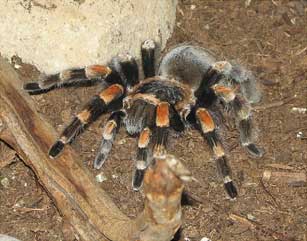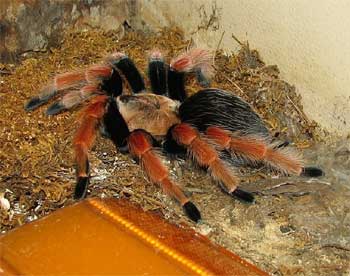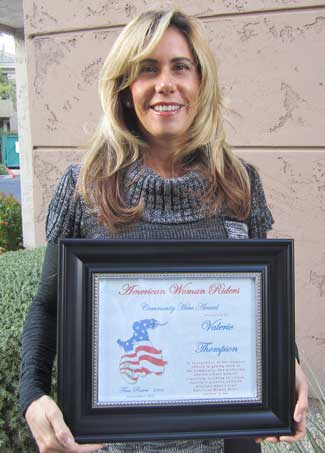BY GERI RODIN | DECEMBER 14, 2011

Tarantula crossing the road
The gentle giants of our
spider world
“A Tarantula! Did you see that?” “No, where?” I said. We were in our Jeep, just having finished the Go John+Overton Trail hike, and it was 3 p.m., about five blocks from the Ranger Gate before leaving Cave Creek Park. Syd said, “I think I just ran over it.” Well, of course this was one of his “testing me” situations, so this time I just said, “Great! I want to see it! Let’s turn around and go back to where you saw it, and hopefully it still lives!” Knowing that he would then say, “Joking!”
But he didn’t, and immediately made a turn like he did the morning on our boat in the Erie Canal when we all screamed that David, our son of 6 years at the time, wearing a winter parka, mittens and hat, had fallen overboard into the canal. Sharp, decisive, and 180 degrees – the jeep still upright – we went back to where Syd thought what he saw was a tarantula crossing the road.
 There she was, only halfway across the southbound lane. Yes, she – as her color was brown and females are usually either blond or brown and are extremely hairy with heavy legs, while males are black with reddish hairs on the abdomen. (Tarantulas seen wandering on the desert at night in the summer are all males out looking for mates. Sometimes they are quite abundant.)
There she was, only halfway across the southbound lane. Yes, she – as her color was brown and females are usually either blond or brown and are extremely hairy with heavy legs, while males are black with reddish hairs on the abdomen. (Tarantulas seen wandering on the desert at night in the summer are all males out looking for mates. Sometimes they are quite abundant.)
One summer evening our friends, Rick and Faith, went with us on an evening desert jeep ride with “black light,” and the only thing we spotted was a Tarantula, and of course right by my door as I got out. And it didn’t leave its “spot” the whole time we were there!
This afternoon, as we watched our “new friend” crossing the road, she appeared to be moving too slowly, and we watched as several cars and pickups pulling horse trailers came up the road going north to the riding area.
We decided that we would stay with her as she crossed the road, as she seemed determined to get to the other side. Female tarantulas are heavier-bodied than males. Another sexual difference is that males have special hooks on the front legs just above the second joint. They use these to hold the female fangs during mating. The male must move beneath the female to about the middle of her abdomen to complete the mating process. After mating, the male quickly backs out of his precarious position, releases the female fangs and runs!
 As “Sadie Spider” is moving to the oncoming North Bound lane, we remark about how Sadie really doesn’t seem to notice us, but do remember that her eyes are incredibly small. Four pairs are located on a small bump in the middle of the cephalothrax. They can’t be of much use in forming an image, so the tarantula probably isn't aware that we are even here, guarding her passage!
As “Sadie Spider” is moving to the oncoming North Bound lane, we remark about how Sadie really doesn’t seem to notice us, but do remember that her eyes are incredibly small. Four pairs are located on a small bump in the middle of the cephalothrax. They can’t be of much use in forming an image, so the tarantula probably isn't aware that we are even here, guarding her passage!
The main defense tarantulas have against consumption by predators is a patch of loose barbed hairs on the abdomen. When disturbed, they move their hind legs back and forth rapidly over this patch of hairs dislodging them into the air where these hairs may lodge in the eyes or nose of the invader, causing irritation and cessation of the predator’s stalk. Sensitive people who come in contact with these hairs may break out in welts. Several people have gotten these hairs lodged in their corneas so care should be taken if one keeps tarantulas as pets.
We “moved traffic” (about four vehicles) around “Sadie” as she finished her non-nocturnal journey across the highway. She was very slow moving, but on a deliberate path for when she finally crossed the highway and was again on desert soil she paused, and I am not sure if her gesture of putting her two front legs together over her head was an indication that she felt we had “championed” the crossing, or perhaps was giving us the “high five” of a journey of friendship, as she was definitely aware of us now as we guarded her heroic venture during this unprecedented daytime event.
Tarantulas are the gentle giants of our spider world. Several species found here in our southwestern desert have a body length of up to about three inches. All species are nocturnal animals, living in holes of their own construction.
They are the “Super Sleuths of the Spider World,” as their holes are lined with silk, but very inconspicuous. Tarantulas go to a great deal of trouble to scatter any soil that they remove well away from the entrance. Its hole is about a foot deep, and angles off to the side in a chamber where the tarantula spends most of its time. What isn’t immediately obvious is that silk strands extend out from the nest entrance. These serve to notify the occupant when potential prey approaches the hole. If the tarantula is down in the hole and not waiting for prey, it places a thin layer of silk across the entrance. And we thought that only super detectives and spies thought of that!
Note: This article was first published in January 1999. Tarantula is of the Genus Aphonopelma. Photos courtesy Wikipedia.
DECEMBER 14, 2011
Two-time land speed record holder Valerie Thompson receives 2011 American Woman Riders Community Hero Award
 SCOTTSDALE – Motorcycle racer and team owner Valerie Thompson has been named the co-recipient of the 2011 American Woman Riders Community Hero Award by the American Woman Riders Association. Thompson's racing accomplishments and community support of the HopeKids children's charity were key criteria for award selection.
SCOTTSDALE – Motorcycle racer and team owner Valerie Thompson has been named the co-recipient of the 2011 American Woman Riders Community Hero Award by the American Woman Riders Association. Thompson's racing accomplishments and community support of the HopeKids children's charity were key criteria for award selection.
The American Woman Riders Community Hero Award was initiated in 2010 to provide recognition of women motorcycle riders who donate time to charities and give selflessly to their community without expecting something in return. "Valerie's many years of supporting the HopeKids organization was a key consideration in selecting her for this year's recognition. She has taken children to drag races, attended movie days, and participated in many fundraising events for the organization. Her motorcycle racing accomplishments in drag racing and land speed record attempts make her an excellent role model for thousands of women riders across the country. Valerie's positive, caring attitude display what a true American Woman Rider strives to be," according to Tina Reeves, President of the American Woman Riders Association.
"This award is a real honor. My parents taught me the importance of "giving back" to the community and helping those less fortunate. I love working with kids, which has been extremely rewarding for me personally. HopeKids does excellent work and it has been a wonderful experience to help support their efforts," said Thompson.
Tammy Wiley from Harker Heights, Texas was the co-recipient of this year’s community hero award, recognizing her work with the "We Fight Like A Girl" ovarian cancer foundation.
Thompson currently holds two land speed records at the famed Bonneville Salt Flats. This year Thompson ran a "personal best" top speed of 201.01 mph at the 8th Annual BUB Speed Trials, outperforming all other BMW's at the event. Thompson also serves as a motorcycle presenter for the world’s largest auto auction company, Barrett-Jackson. Thompson's current goals include setting additional land speed records and becoming a member of the “200 MPH Club.” Current sponsors include: CTEK battery chargers, TROON Enterprises, Swisstrax, Hawthorne CAT of San Diego, Stand Up Photos, and Alter/Bivins Racing.
American Women Riders Association Background
 Founded in 2010, the American Woman Riders Association began as a New Mexico online magazine for women who love to drive and ride motorcycles. The online magazine has grown quickly and now has international members in Italy, Germany, Spain, New Zealand, and Australia. American Woman Riders celebrates all the grandmothers, mothers, and daughters who love riding the open road.
Founded in 2010, the American Woman Riders Association began as a New Mexico online magazine for women who love to drive and ride motorcycles. The online magazine has grown quickly and now has international members in Italy, Germany, Spain, New Zealand, and Australia. American Woman Riders celebrates all the grandmothers, mothers, and daughters who love riding the open road.





